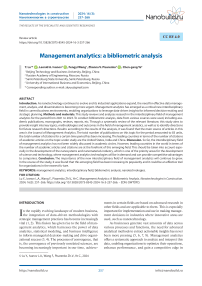Management Analytics: A Bibliometric Analysis
Автор: Lu Y., Ivanov L.A., Wang F., Pisarenko Zh.V., Ye C.
Журнал: Nanotechnologies in Construction: A Scientific Internet-Journal @nanobuild-en
Рубрика: The results of the specialists’ and scientists’ researches
Статья в выпуске: 3 Vol.16, 2024 года.
Бесплатный доступ
Introduction. As nanotechnology continues to evolve and its industrial applications expand, the need for effective data management, analysis, and dissemination is becoming more urgent. Management analytics has emerged as a critical new interdisciplinary field in current business environments, enabling organizations to leverage data-driven insights for informed decision-making and strategic planning. Methods and materials. This study reviews and analyzes research in the interdisciplinary field of management analytics for the period from 2021 to 2023. To conduct bibliometric analysis, data from various sources were used, including academic publications, monographs, reviews, reports, etc. Through a systematic review of the relevant literature, this study aims to provide insight into key topics, methodologies and outcomes in the field of management analytics, as well as to identify directions for future research directions. Results: according to the results of the analysis, it was found that the main source of articles in this area is the Journal of Management Analytics. The total number of publications on this topic for the period amounted to 83 units, the total number of citations for a certain time period has been increasing. The leading countries in terms of the number of citations of academic articles on the topic under study are the United States, India and China. Discussion. So far, the interdisciplinary field of management analytics has not been widely discussed in academic circles. However, leading countries in the world in terms of the number of academic articles and citations are at the forefront of this emerging field. This should be taken into account especially in the development of the nanosystems and nanomaterials industry, which is one of the priority areas for the development of science and technology, where management analytics technologies will be in demand and can provide competitive advantages to companies. Conclusion. The importance of the new interdisciplinary field of management analytics will continue to grow. In the course of the study, it was found that this emerging field has been increasing its popularity and it could be an effective tool for organizations in the nearest fu-ture.
Management analytics, interdisciplinary field, bibliometric analysis, nanotechnologies
Короткий адрес: https://sciup.org/142240871
IDR: 142240871 | DOI: 10.15828/2075-8545-2024-16-3-257-266
Текст научной статьи Management Analytics: A Bibliometric Analysis
Review article
Lu Y., Ivanov L.A., Wang F., Pisarenko Zh.V., Ye C. Management Analytics: A Bibliometric Analysis. Nanotechnologies in Construction. 2024; 16(3): 257–266. – EDN: GWTOFD.
In the rapidly evolving landscape of modern business, the integration of data-driven methodologies with strategic management practices has become increasingly vital (1, 2). This fusion has given rise to the field of management analytics, which harnesses the power of data analytics, statistical modeling, and business intelligence to inform managerial decision-making and drive organizational success (3, 4). The processes of convergence, that is, the convergence of previously unrelated sciences, are becoming increasingly important in our time, achieve- ments in certain fields are based on advanced research in other fields and are applicable to them. This is especially important for implementation and use in making management decisions in industries where innovative areas are used, such as nanotechnology.
As businesses generate vast amounts of data across various processes and functions, the need for advanced analytical methods to extract actionable insights has never been more pressing (5, 6, 7, 8). Management analytics offers a systematic approach to analyze and interpret this data, enabling organizations to optimize their operations, enhance performance, and gain a competitive edge in
THE RESULTS OF THE SPECIALISTS’ AND SCIENTISTS’ RESEARCHES today’s dynamic market environment (9). For countries with transitive economies, Management analytics plays a special role, as it allows you to process a lot of data with greater speed and accuracy and make the right management decisions, which ultimately increases the competitiveness of domestic companies.
The field of management analytics encompasses a diverse array of approaches, including descriptive analytics, which focuses on summarizing historical data to identify patterns and trends; predictive analytics, which leverages statistical techniques and machine learning algorithms to forecast future outcomes (10, 11, 12,13); and prescriptive analytics, which provides recommendations for decision-making based on optimization and simulation models. By leveraging these analytical tools and techniques, organizations can gain valuable insights into their business processes, customer behavior, market trends, and competitive landscape, enabling them to make informed decisions and drive business growth (14, 15, 16, 17).
Despite the growing importance of management analytics, there remains a need for comprehensive literature analysis to understand the current state of research, identify emerging trends, and uncover gaps in existing knowledge. This bibliographic analysis aims to address these needs by synthesizing and analyzing the existing literature on management analytics. By systematically reviewing the relevant literature, this study seeks to provide insights into the key themes, methodologies, and findings in the field of management analytics, as well as to offer recommendations for future research directions. Through this analysis, we aim to contribute to the ongoing dialogue and advancement of knowledge in the field of management analytics.
The structure of the paper is as follows. Section 2 depicted the current status of management analytics. Section 3 introduced the method used. Section 4 illustrates the descriptive analyses. Section 5 explores the network analyses. Section 6 offers the discussions. Section 7 is the conclusion.
THE CURRENT STATUS OF MANAGEMENT ANALYTICS
The current status of management analytics reflects a dynamic landscape shaped by the increasing adoption of data-driven decision-making across various industries and sectors. Organizations are leveraging advanced analytics tools and techniques to extract actionable insights from vast and diverse datasets, with the aim of enhancing operational efficiency, driving innovation, and gaining a competitive edge in the market (18, 19, 20).
One prominent trend in the current status of management analytics is the proliferation of big data and analytics technologies. With the exponential growth of data generated by digital technologies, organizations are investing heavily in data infrastructure, analytics platforms, and talent to harness the potential of big data for strategic decision-making (21, 22). This includes the adoption of cloud-based analytics solutions, machine learning algorithms, and artificial intelligence (AI) capabilities to analyze and interpret large volumes of structured and unstructured data (23, 24, 25).
Another key aspect of the current status of management analytics is the integration of analytics into core business functions and processes. Analytics is no longer confined to specialized departments or roles but is increasingly embedded into day-to-day operations across all levels of the organization. This integration enables real time monitoring, predictive modeling, and prescriptive recommendations to drive informed decision making and strategic planning (26, 27). Such integration is particularly important for organizations implementing innovative nanotechnologies in a variety of industries. For example, in medicine, nanotechnology and management analytics technologies, which use large data sets, can combine to create therapies that can be precisely tailored to the individual needs of patients. Decision-making is based on better and more accurate patient data through the development of low-cost, passive, intelligent sensor devices based on nanotechnology (28).
Moreover, the current status of management analytics underscores the importance of data governance, privacy, and ethics. As organizations collect and analyze sensitive data, there is a growing emphasis on ensuring data security, compliance with regulations such as General Data Protection Regulation (GDPR), and ethical use of data (29, 30). This includes implementing robust data governance frameworks, establishing clear data privacy policies, and fostering a culture of responsible data stewardship within the organization (31, 32).
Overall, the current status of management analytics is characterized by rapid advancements in technology, evolving organizational practices, and an increasing recognition of the transformative potential of data-driven decision-making. As organizations continue to embrace analytics as a strategic imperative, the field of management analytics is poised for further growth and innovation in the years to come.
METHODOLOGY
Bibliometrics is a discipline that utilizes mathematical and statistical methods to quantitatively analyze detailed information from books and other communication media. Techniques, such as bibliographic coupling, co-citation analysis, co-authorship networks, and keyword co-occurrence analysis, were used to examine the selected papers (33, 34, 35). The data for the preparation of this review article were obtained from open sources.
THE RESULTS OF THE SPECIALISTS’ AND SCIENTISTS’ RESEARCHES
DESCRIPTIVE ANALYSIS
Main Information About Data
Table 1 presents descriptive statistics pertaining to the selected search records for subsequent analysis. In the field of management science spanning the years 2021 to 2023, a total of 83 articles were published in the Journal of Management Analytics. The mean citations per document stand at 2.07. These publications are classified into three types: 74 ‘articles’, 1 ‘article; early access,’ and 8 ‘reviews’. Combined, these publications feature 374 Author’s Keywords. Additionally, they involve 220 unique authors, of whom only 8 have contributed single-authored articles, totaling 36 such documents. On average, each publication involves 2.65 authors or 3.04 co-authors, with a Collaboration Index of 2.86, indicative of the significance of collaborative research within management analytics.
Year-wise publication trend
Figure 1 illustrates that 2021 marked the peak year for published articles, totaling 32 articles. Subsequently, over the ensuing two years, the number of published articles declined, with 5 articles in 2022 and 26 articles in 2023.
Most Relevant Sources
To find relevant publications on management analytics, we examined the peer-reviewed scholarly Journal of Management Analytics, which covers a range of topics related to analytics, decision-making, and management.
Table1
Main Information About Data
|
Description |
Results |
|
Main information about data |
|
|
Timespan |
2021:2023 |
|
Sources (Journals, Books, etc.) |
1 |
|
Documents |
83 |
|
Average years from publication |
2.07 |
|
Document types |
|
|
article |
74 |
|
article; early access |
1 |
|
review |
8 |
|
Document contents |
|
|
Author’s Keywords (DE) |
374 |
|
Authors |
|
|
Authors |
220 |
|
Author Appearances |
252 |
|
Authors of single-authored documents |
8 |
|
Authors of multi-authored documents |
212 |
|
Authors collaboration |
|
|
Single-authored documents |
9 |
|
Authors per Document |
2.65 |
|
Co-Authors per Documents |
3.04 |
|
Collaboration Index |
2.86 |
Annual Production
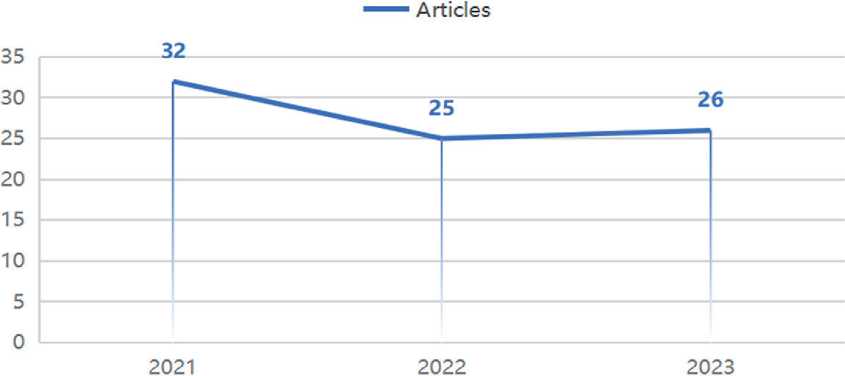
Fig. 1. Annual Production of the Articles, 2021–2023
THE RESULTS OF THE SPECIALISTS’ AND SCIENTISTS’ RESEARCHES
Journal of Management Analytics has become the most prominent publication in the field of management analytics with 83 articles. Therefore, we used these 83 articles as research samples (Table 2).
Table 2
Most Relevant Sources
|
Sources |
Articles |
|
JOURNAL OF MANAGEMENT ANALYTICS |
83 |
Most frequent words
The most frequently used words and expressions in academic articles on a specific topic show the key concepts, themes, and terminology that are central to that field of research. Analyzing the word frequencies can provide insights into: Fundamental theories and models, emerging trends and hot topics, etc. (36)
Figure 2 displays the word cloud derived from 83 articles, whereas Table 3 lists the most commonly encountered terms within the compiled articles. Through both visual and tabular representations, it becomes evident that “inventory” emerges as the most frequently cited term, followed by other prominent terms such as “ma- chine learning,” “deep learning,” “genetic algorithm,” “supply chain,” and others.
Then, after identifying the most common words and expressions, we ranked them by the frequency of their appearance in the studied array of articles.
The next step is to determine from which countries the research of scientists has the largest number of citations.
Table 3
Most Frequent Words
data envelopmentanalysis … … supply сһаіп№Ш1і( f
_______11 green-sensitive demand . ■ . artificial intelligence [ai]
machinelearning^^
—ПІІЛ П*Л Mllhealthcare
—-ІІПдН ■ ■ ■ ■ ■ ■ ■ ■>ВИэЧтапсева7Ш8П1
industry 4 ■ ■ ■ If U 11 ・U game 嚅器肝"毕呵呪蠱無鹽 —Геіишс а1дог1№тпши$!п4оа№,8 —_嘲黜聯需肥 Sullrfuzzvnumber
airline envirenmenial efficiency backlogging:
^ncnronous caienaar etlects
advertisement-and green-sensitive demand
artificial iniemgence [ail
^gncsiinre
amazon customer r^iev ensemble learnini
industry 4
dynamic vehicle routing problem smictural equation modeling
healthcare
'advance payment
featere selection
Fig. 2. Word Cloud from Relevant Articles
THE RESULTS OF THE SPECIALISTS’ AND SCIENTISTS’ RESEARCHES
Most cited countries
Table 4 presents the top 10 countries representative of their citation performance, showcasing both their total citation counts and average article citation counts. While the United States leads in total citations, it ranks third in average article citation. INDIA secures the second position in total citations but lags in average article citation, standing at eighth. China holds the third position in total citations, with these three nations holding a substantial lead over others. Moreover, BRAZIL boasts the highest average number of article citations, despite ranking fifth in total citations. These countries have significantly contributed to the field of management analytics, with additional noteworthy contributors including IRAN, PHILIPPINES, SRI LANKA, among others.
NETWORK ANALYSIS
Conceptual Structures
Figure 3 depicts the co-word analysis network comprising 8 keywords, organized into 4 clusters. The initial cluster encompasses 2 key terms, namely “inven-
Table 4
Countries: most сited articles
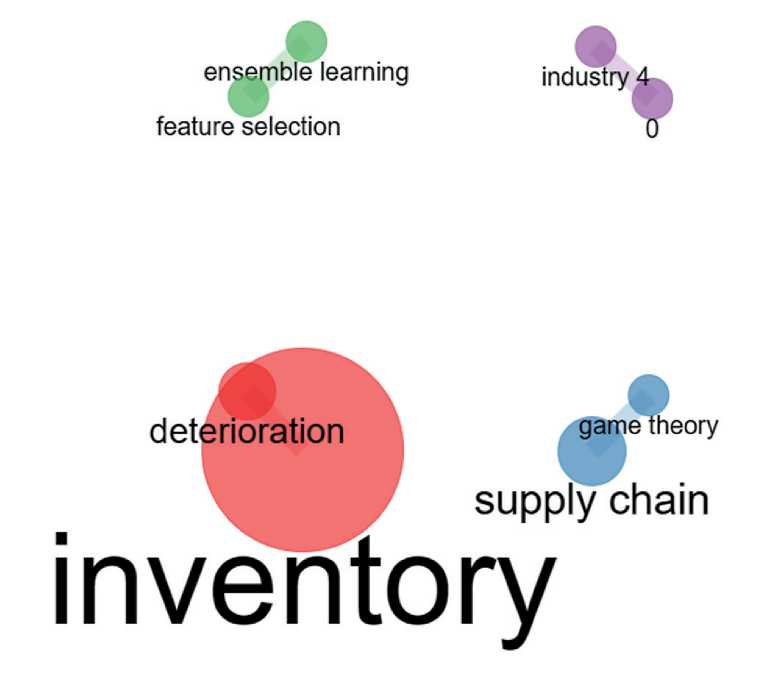
Fig. 3. Keyword: Сo-occurrence Network
THE RESULTS OF THE SPECIALISTS’ AND SCIENTISTS’ RESEARCHES fourth cluster incorporates 2 keywords: “industry 4” and “0.” These primary keywords shed light on prominent research themes and con-tent in recent years, while also emphasizing the interconnectedness of these topics within the domain of management science and its affiliated areas.
Figures 4 present thematic maps derived from authors’ keywords and indexed keywords. These thematic networks are instrumental in revealing inherent linkages within a subject, uncovering latent patterns, and pinpointing pivotal concepts or components, thereby enhancing comprehension of the composition and framework of a particular theme. In Figure 4, a thematic network is depicted, showcasing the interconnections among review articles concerning management science, with these themes categorized into 10 clusters. From the visualization, it’s apparent that subjects like inventory, deep learning, decision-making, and genetic algorithms are focal points within the domain of management science.
Collaboration Structures
Figure 5 displays the collaborative bond among nations. Based on this collaboration, these countries are primarily segmented into four groups. China exhibits the highest central value within this network, succeeded by Australia, Denmark, and the United States.
DISCUSSION
Applications and Use Cases
One of the central themes in discussions about management analytics is the myriad of applications across different industries and organizational functions. Participants often share examples of how analytics is being used to optimize business processes, improve decision-making, enhance customer experiences, and drive innovation. Case studies and real-world examples are frequently cited to illustrate the practical impact of analytics in various contexts (37, 38, 39). Convergence of nanotechnology and data driven analytics is the case (40, 41).
Technology and Tools
Discussions about management analytics also delve into the latest technologies and tools shaping the field (42). Participants may explore emerging trends such as artificial intelligence, machine learning, predictive analytics, and big data platforms. They may discuss the benefits
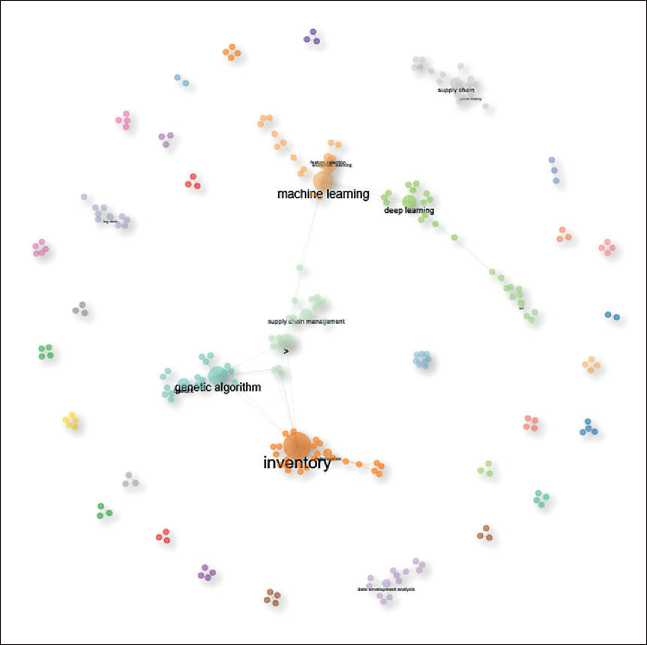
Fig. 4. Thematic Network
THE RESULTS OF THE SPECIALISTS’ AND SCIENTISTS’ RESEARCHES
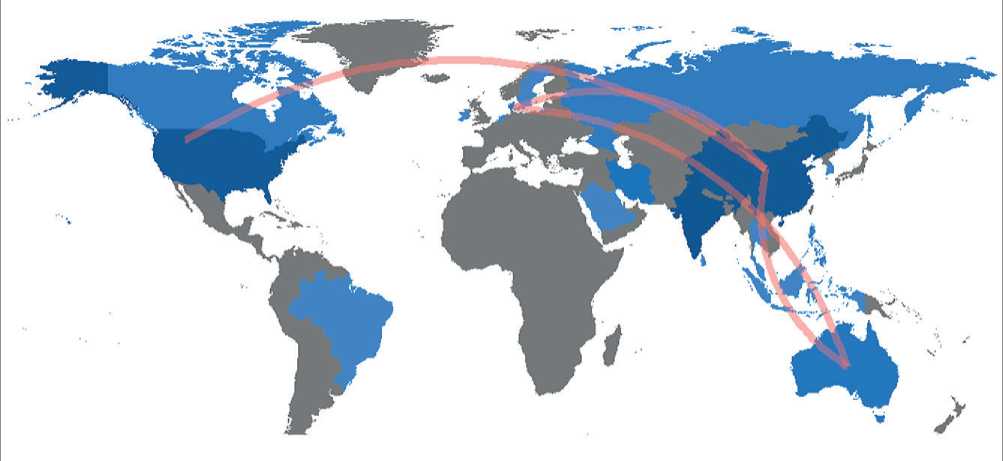
Fig. 5. Country Collaboration Map
and limitations of different analytics tools, as well as considerations for selecting the most appropriate technology stack for specific use cases (43, 44).
Data Governance and Ethics
Another important topic in discussions about management analytics is data governance, privacy, and ethics. Participants often examine the ethical implications of data collection, storage, and analysis, particularly in relation to issues such as data privacy, consent, and bias (45, 46).
It is crucial that management analytics tools for nanotechnology requires special knowledge and skills, taking into account the specifics of know-how, trade secrets, etc. Experts in this field need not only a deep understanding of the technical aspects of nanotechnology, but also the ability to effectively work with big data and apply modern methods of modeling and analysis. They also need ethical skills when dealing with information. Therefore, it is necessary to pay attention to the lack of publications on training personnel in management analytics, especially in the field of information security at innovative enterprises (47).
CONCLUSION
In conclusion, management analytics represents a powerful toolset for organizations seeking to harness the potential of data-driven decision-making. Through the integration of advanced technologies, such as artificial intelligence, machine learning, and big data analytics, management analytics enables organizations to gain valuable insights, optimize operations, and drive innovation. However, while the benefits of management analytics are clear, realizing its full potential requires overcoming various challenges. As organizations continue to embrace management analytics, it is essential to prioritize investments in data infrastructure, talent development, and cultural transformation. By fostering a data-driven culture and investing in the right technology stack, organizations can unlock new opportunities for growth, efficiency, and competitiveness. Moreover, as the field of management analytics evolves, it is crucial to stay abreast of emerging trends and best practices, and to continuously reassess and refine analytics strategies to meet evolving business needs.
Список литературы Management Analytics: A Bibliometric Analysis
- Ivanov L.A., Xu L.D., Bokova E.S., Ishkov A.D., Muminova S.R. Inventions of scientists, engineers and specialists from different countries in the area of nanotechnologies. Part I. Nanotechnologies in Construction. 2021; 13(1): 23–31. https://doi.org/10.15828/2075-8545-2021-13-1-23-31
- Ivanov L.A., Xu L.D., Pisarenko Zh.V., Wang Q., Prokopiev P.S. Inventions of scientists, engineers and specialists from different countries in the area of nanotechnologies. Part II. Nanotechnologies in Construction. 2021; 13(2): 79–89. https://doi.org/10.15828/2075-8545-2021-13-2-79-89
- Ivanov L.A., Xu L.D., Bokova E.S., Ishkov A.D., Borisova O.N. Inventions in the area of nanomaterials and nanotechnologies. Part I. Nanotechnologies in Construction. 2022; 14(1): 18–26. https://doi.org/10.15828/2075-8545-2022-14-1-18-26
- Ivanov L.A., Xu L.D., Muminova S.R., Ishkov A.D., Demenev A.V. Inventions in the area of nanomaterials and nanotechnologies. Part III. Nanotechnologies in Construction. 2022; 14(6): 466–474. https://doi.org/10.15828/2075-8545-2022-14-6-466-474. – EDN: QGCTUF.
- Ivanov L.A., Xu L.D., Razumeev K.E., Feoktistova V.M., Prokopiev P.S. Inventions of scientists, engineers and specialists from different countries in the area of nanotechnologies. Part V. Nanotechnologies in Construction. 2021; 13(5): 311–318. https://doi.org/10.15828/2075-8545-2021-13-5-311-318
- Sigov A., Ratkin L., Ivanov L.A., Zuo M. Quantum computing and industrial information integration: A review. Journal of Industrial Information Integration. 2023; 23:100511. https://doi.org/10.1016/j.jii.2023.100511
- Sigov A., Ratkin L., Ivanov L.A. Quantum information technology. Journal of Industrial Information Integration. 2022; 1;28:100365. https://doi.org/10.1016/j.jii.2022.100365
- Ivanov L.A., Xu L.D., Razumeev K.E., Pisarenko Zh.V., Demenev A.V. Inventions of scientists, engineers and specialists from different countries in the area of nanotechnologies. Part VI. Nanotechnologies in Construction. 2021; 13(6): 370–378. https://doi.org/10.15828/2075-8545-2021-13-6-370-378
- Chawla P., Gao J.Z., Gao T., Luo C., Li H., We Y. An interactive web-based solar energy prediction system using machine learning techniques. Journal of Management Analytics. 2023; (10:2): 308-335.
- Saragih H.S. Predicting song popularity based on Spotify’s audio features: insights from the Indonesian streaming users. Journal of Management Analytics. 2023; (10:4): 693-709.
- Gurusinghe R.N., Arachchige B.J.H., Dayarathna D. Predictive HR analytics and talent management: a conceptual framework. Journal of Management Analytics. 2021; (8:2): 195-221.
- Wang X., Zhi J. A machine learning-based analytical framework for employee turnover prediction. Journal of Management Analytics. 2021; (8:3): 351-370.
- Hosseini S. A decision support system based on machined learned Bayesian network for predicting successful direct sales marketing. Journal of Management Analytics. 2021; (8:2): 295-315.
- Liu Q., Yu M., Xiong B., Cai Z., Zhang P., Tan C. Health analytics in business research: a literature review. Journal of Management Analytics. 2023; (10:3): 447-476.
- Fu L., Li Ling, Li Lusi, Zhang W., Luo Z. Impact of hospital size on healthcare information system effectiveness: evidence from healthcare data analytics. Journal of Management Analytics. 2021; (9:2): 211-231.
- Wang H., Zhang M., Ying H., Zhao X. The impact of blockchain technology on consumer behavior: a multimethod study. Journal of Management Analytics. 2021; (8:3): 371-390.
- Ivanov L.A., Xu L.D., Pisarenko Zh.V., Muminova S.R., Miloradova N.G. Inventions in the area of nanotechnologiesand nanomaterials. Part I. Nanotechnologies in Construction. 2023; 15(1): 37–47. https://doi.org/10.15828/2075-8545-2023-15-1-37-47. – EDN: PPOMEI.
- Zhou S., Zhan Y. A new method for performance evaluation of decision-making units with application to service industry. Journal of Management Analytics. 2021; (8:1): 84-100.
- Yin S., Zhang N., Xu J. Information fusion for future COVID-19 prevention: continuous mechanism of big data intelligent innovation for the emergency management of a public epidemic outbreak. Journal of Management Analytics. 2021; (8:3): 391-423.
- Norinder U., Norinder P. Predicting Amazon customer reviews with deep confidence using deep learning and conformal prediction. Journal of Management Analytics. 2022; (9:1): 1-16.
- Iaksch J., Fernandes E., Borsato M. Digitalization and Big data in smart farming – a review. Journal of Management Analytics. 2021; (8:2): 333-349.
- Ableeva A., Salimova G., Lubova T., Farrahetdinova A., Siraeva R. Evaluation of the efficiency of fixed assets of economic sectors based on index analysis. Journal of Management Analytics. 2022; (9:3): 369-382.
- Li X., Sigov A., Ratkin L., Ivanov L.A., Li L. Artificial intelligence applications in finance: a survey. Journal of Management Analytics. 2023; 2;10(4):676-92. https://doi.org/10.1080/23270012.2023.2244503
- Chen H., Li L., Chen Y. Explore success factors that impact artificial intelligence adoption on telecom industry in China. Journal of Management Analytics. 2021; (8:1): 36-68.
- Garg D., Alam M. Smart agriculture: a literature review. Journal of Management Analytics. 2023; (10:2): 359-415.
- Bradbury J.D., Guadagno R.E. Enhanced data narratives. Journal of Management Analytics. 2021; (8:2): 171-194.
- Mohammadi S.S., Azar A., Ghatari A.R., Alimohammadlou M. A model for selecting green suppliers through intervalvalued intuitionistic fuzzy multi criteria decision making models. Journal of Management Analytics. 2022; (9:1): 60-85.
- Shitharth S., Meshram P., Kshirsagar P.R., Manoharan H., Tirth V., Sundramurthy V.P. Impact of Big Data Analysis on Nanosensors for Applied Sciences Using Neural Networks. Journal of Nanomaterials. 2021; ID 4927607. https://doi.org/10.1155/2021/4927607
- Xie S., Gan C. Classification of territory risk by generalized linear and generalized linear mixed models. Journal of Management Analytics. 2023; (10:2): 223-246.
- Pan S., Ye Q., Shi W. Using a novel ensemble learning framework to detect financial reporting misconduct. Journal of Management Analytics. 2023; (10:4): 607-624.
- Mahato C., Mahata G.C. Decaying items inventory models with partial linked-to-order upstream trade credit and downstream full trade credit. Journal of Management Analytics. 2021; (9:1): 137-168.
- Charoontham K., Worakantak J., Kanchanapoom K., Tancho N. A countermeasure designed to restrain self-serving behavior and strategic rating disclosure of credit rating agencies. Journal of Management Analytics. 2023; (10:3): 550-565.
- Naveen, Donthu, Kumar S., Mukherjee D., Pandey N., Lim W.M. How to conduct a bibliometric analysis: An overview and guidelines. Journal of business research. 2021; (133): 285-296.
- Magaly, Marin, Merigo J.M., Popa S. Twenty years of the Journal of Knowledge Management: A bibliometric analysis. Journal of Knowledge Management. 2018; (22:8): 1655-1687.
- Talafidaryani, Mojtaba, Jalali S. M. J., Moro S. Tracing the evolution of digitalisation research in business and management fields: Bibliometric analysis, topic modelling and deep learning trend forecasting. Journal of Information Science. 2023; 01655515221148365.
- Pournia Y. A Study on the Most Frequent Academic Words in High Impact Factor English Nursing Journals: A Corpus-based Study. Iran J Nurs Midwifery Res. 2019;24(1):11-17. doi: 10.4103/ijnmr.IJNMR_190_17. PMID: 30622572; PMCID: PMC6298166.
- Rahiminia M., Shahrabifarahani S., Mojaradi Z., Aghsami A., Jolai F. A queueing-inventory model to control the congestion of patients and medical waste in the medical centers, a case study. Journal of Management Analytics. 2023; (10:2): 416-445.
- Ocampo L.A., Vasnani N.N., Chua F.L.S., Pacio L.B.M., Galli B.J. A bi-level optimization for a make-to-order manufacturing supply chain planning: a case in the steel industry. Journal of Management Analytics. 2021; (8:4): 598-621.
- Solomon S., Ellegood W. A., Pannirselvam G., Riley J. A decision support model for supplier portfolio selection in the retail industry. Journal of Management Analytics. 2021; (8:3): 486-501.
- Gopukumar S. T. Nano Informatics: The Bridge between Nanotechnology and Data Science. Nanonamed and Nanotechnol 2024, 9(1): 000281. 10.23880/nnoa-16000281.
- Gurjar R.S., Kumar S. Innovative Practices in Nanotechnology through Artificial Intelligence. Nanomedicine and Nanotechnology. 2024; 9(2). https://doi.org/10.23880/nnoa-16000310
- Thomann, Eva, Maggetti M. Designing research with qualitative comparative analysis (QCA): Approaches, challenges, and tools. Sociological Methods & Research. 2020; (49:2): 356-386.
- Sharbini H, Sallehuddin R., Haron H. Crowd evacuation simulation model with soft computing optimization techniques: a systematic literature review. Journal of Management Analytics. 2023; (8:3): 443-485.
- Sigov A., Ratkin L., Ivanov L.A. Emerging Enabling Technologies for Industry 4.0 and Beyond. Information Systems Frontiers. 2022. https://doi.org/10.1007/s10796-021-10213-w
- Kim J. H. 6G and Internet of Things: a survey. Journal of Management Analytics. 2021; (8:2): 316-332.
- Chen W., He W., Shen J., Tian X., Wang X. Systematic analysis of artificial intelligence in the era of industry 4.0. Journal of Management Analytics. 2023; (10:1): 89-108.
- Ionescu A.M. Nanotechnology and Global Security. Connections QJ. 2016; 15(2):31-47. https://doi.org/10.11610/Connections.15.2.03

